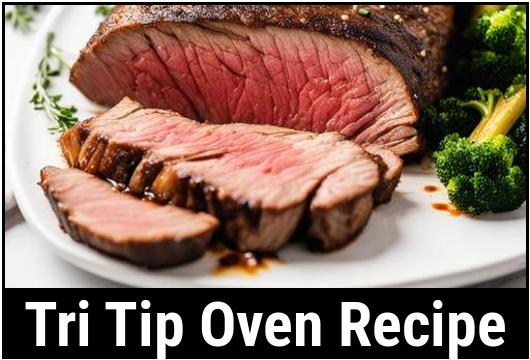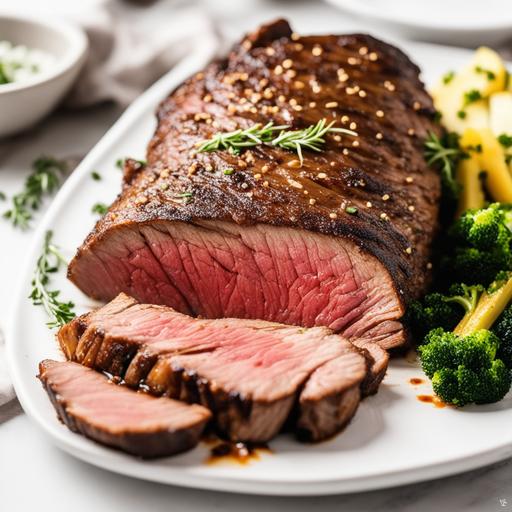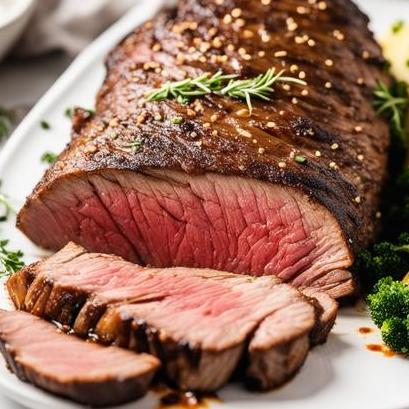
Tri Tip Oven Recipe: The Ultimate Guide To A Juicy And Flavorful Delight
There’s nothing quite like the mouthwatering aroma of a perfectly cooked tri tip roast wafting through your kitchen. This cut of meat, known for its tenderness and rich flavor, is a favorite among BBQ enthusiasts and culinary experts alike. Whether you’re a seasoned pro or a cooking novice, this comprehensive guide will equip you with all the knowledge and techniques you need to prepare a tri tip roast to perfection right in your oven.
The Science Behind Tri Tip: Understanding the Cut
Before we delve into the details of cooking a tri tip roast, it’s essential to understand the science behind this mouthwatering cut of meat. Tri tip comes from the bottom portion of the sirloin, a muscle group located towards the back of the cow. It is a triangular-shaped roast with a generous amount of marbling, or intramuscular fat, which contributes to its incredible flavor and tenderness.
The marbling in tri tip acts as a natural basting agent, keeping the meat moist and juicy during the cooking process. Moreover, its unique triangular shape helps distribute heat evenly when cooked, leading to a consistent level of doneness throughout the roast.
Selecting and Preparing Tri Tip
Choosing the perfect tri tip roast is crucial for a successful culinary adventure. Look for a cut that has a bright red color, free of excessive blemishes or discoloration. Opt for a roast with a good amount of marbling, as it ensures maximum flavor and tenderness.
Once you have selected your tri tip, it’s essential to give it some extra love and attention to make your meal truly exceptional. Follow these steps to prepare your tri tip for cooking:
1. Cleaning the Tri Tip
-
Begin by rinsing the tri tip under cold running water to remove any impurities or surface bacteria.
-
Pat it dry using paper towels, ensuring the meat is completely moisture-free.
2. Trimming Excess Fat
- Trim any excessive fat from the surface of the tri tip. While a little marbling is desirable, removing large chunks of fat will prevent flare-ups during cooking and allow for better seasoning penetration.
3. Seasoning
- Apply a generous amount of your favorite dry rub, seasoning blend, or marinade to the tri tip. Ensure you cover all sides of the roast, gently pressing the seasonings into the meat to enhance flavor.
4. Letting it Rest
- Allow the seasoned tri tip to rest at room temperature for about 30 minutes. This step ensures even cooking and enhances the tenderness of the meat.
Tips for Cooking Tri Tip in the Oven

Now that your tri tip is perfectly prepared, it’s time to move on to the cooking process. While tri tip is traditionally prepared using a grill, achieving fantastic results in your oven is entirely possible. Follow these tips and techniques to master the art of baking tri tip to perfection:
1. Preheating the Oven
- Before you begin cooking, preheat your oven to 425°F (220°C). The high temperature promotes a nicely seared exterior while preserving the moisture inside the roast.
2. Choosing the Right Pan
-
Select an oven-safe roasting pan or cast-iron skillet that comfortably accommodates the size of your tri tip roast.
-
Consider using a wire rack inside the pan to elevate the roast. This helps promote even heat circulation and allows excess fat to drain, resulting in a crispier crust.
3. Searing the Tri Tip
- Heat a little oil over medium-high heat in a stovetop-safe roasting pan or skillet. Carefully sear each side of the tri tip until a beautiful golden-brown crust forms. This process locks in the flavors and provides an appetizing appearance.
4. Transitioning to the Oven
- Once seared, transfer the pan with the tri tip into the preheated oven. Allow the roast to cook, uncovered, until it reaches the desired level of doneness. Aim for an internal temperature of 130-135°F (55-57°C) for medium-rare, which offers the best balance of tenderness and flavor.
5. Resting Period
- Once the tri tip has reached the desired doneness, remove it from the oven and let it rest on a cutting board for 10-15 minutes. Resting allows the meat juices to redistribute, resulting in a juicier final product.
Checking for Doneness

Achieving the perfect level of doneness is a crucial consideration when cooking tri tip. While timing can provide an approximate guideline, checking the internal temperature of the roast with a meat thermometer is the most reliable method. Here are the recommended internal temperatures for various levels of doneness:
-
Medium-Rare: 130-135°F (55-57°C)
-
Medium: 135-140°F (57-60°C)
-
Medium-Well: 140-145°F (60-63°C)
To check the internal temperature of your tri tip, insert the meat thermometer into the thickest part of the roast, avoiding contact with bone or excessive fat. Allow the thermometer to rest for a few seconds to get an accurate reading.
A Classic Tri Tip Oven Recipe

Now that you have mastered the science and techniques behind cooking tri tip, let’s dive into a classic recipe that is sure to impress your family and friends. Gather the following ingredients:
-
1 ½ – 2 pounds (680-900g) of tri tip roast
-
Your choice of dry rub or seasoning blend (approximately 2 tablespoons)
-
Olive oil (1-2 tablespoons)
-
Salt and pepper to taste
Instructions:
-
Preheat your oven to 425°F (220°C).
-
Season the tri tip with your chosen dry rub or seasoning blend, ensuring it is evenly coated on all sides of the roast. Add salt and pepper to taste.
-
Heat olive oil in an oven-safe skillet or roasting pan over medium-high heat.
-
Sear the tri tip on all sides until a golden-brown crust forms.
-
Transfer the skillet or roasting pan into the preheated oven.
-
Cook the tri tip uncovered for approximately 20-30 minutes, or until reaching an internal temperature of 130-135°F (55-57°C) for medium-rare doneness.
-
Remove the tri tip from the oven and let it rest on a cutting board for 10-15 minutes.
-
Slice the tri tip against the grain into thin strips and serve with your favorite sides or as the star of a delectable sandwich.
Exploring Variations and Tips

While the classic recipe above provides an excellent starting point, there are endless variations and tips to create your unique tri tip roast masterpiece. Here are a few ideas to get you started:
1. Marinating Magic
- Instead of using a dry rub, try marinating the tri tip overnight for an added depth of flavor. Experiment with combinations of garlic, soy sauce, vinegar, herbs, and spices to suit your taste.
2. Flavorful Smoking
- If you are a fan of smoky flavors, consider using a stovetop smoker or adding wood chips to your oven to infuse your tri tip with aromatic smoke during the cooking process.
3. Sous Vide Technique
- For ultimate precision and tenderness, try the sous vide method in combination with the oven. This involves sealing the seasoned tri tip in a vacuum-sealed bag and cooking it in a water bath at a controlled temperature before finishing it in a hot oven to develop the crust.
4. Temperature Probing
- Utilize a leave-in meat thermometer with an alarm feature for real-time temperature monitoring, allowing you to achieve the perfect level of doneness without opening the oven door repeatedly.
The Art of Appreciating Tri Tip
In conclusion, tri tip is a true culinary gem that brings a burst of flavor to any dining experience. By understanding the science behind this cut, selecting and preparing it with care, and following the tried-and-true oven cooking methods outlined in this guide, you can create a tri tip masterpiece that will delight your taste buds and impress your guests. So why wait? Embrace the journey of becoming a tri tip aficionado, and let the magic unfold in your kitchen!
Sources
FAQS On Tri Tip Oven Recipe
What Is Tri Tip?
Tri tip is a flavorful and tender cut of beef that comes from the bottom sirloin primal cut of the cow. It is a triangular-shaped roast that is known for its rich marbling, robust beefy flavor, and versatility in cooking methods.
How Do I Select A Good Quality Tri Tip?
When selecting a tri tip, look for a piece that has a significant amount of marbling, as this fat contributes to the tenderness and juiciness of the meat. Additionally, choose a tri tip that has a bright red color and is firm to the touch. Avoid any pieces that appear discolored or have a strong odor.
What Are Some Recommended Seasonings For A Tri Tip Oven Recipe?
There are numerous delicious seasonings that can enhance the flavor of a tri tip when cooked in the oven. A popular option is a simple combination of salt, black pepper, garlic powder, and onion powder. Other seasonings, such as paprika, chili powder, rosemary, or thyme, can also be added for additional depth of flavor.
What Is The Recommended Cooking Time And Temperature For A Tri Tip In The Oven?
To achieve optimal tenderness and doneness, it is recommended to cook a tri tip in the oven at a relatively high temperature. Preheat your oven to 425°F (220°C) and bake the tri tip for about 25-30 minutes for medium-rare or 30-35 minutes for medium. Remember to use a meat thermometer to ensure the internal temperature reaches 135°F (57°C) for medium-rare or 145°F (63°C) for medium.
How Should I Carve A Cooked Tri Tip?
After removing the tri tip from the oven, allow it to rest for about 10 minutes to let the juices redistribute and the meat to become more tender. To carve the tri tip, locate the natural grain of the meat and slice against it into thin slices. This technique ensures maximum tenderness and reduces the likelihood of chewiness.



